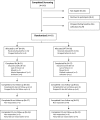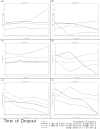An eating disorder randomized clinical trial and attrition: profiles and determinants of dropout
- PMID: 21472754
- PMCID: PMC3107987
- DOI: 10.1002/eat.20800
An eating disorder randomized clinical trial and attrition: profiles and determinants of dropout
Abstract
Objective: This study sought to determine whether differential treatment effects in the targeted mechanisms of change and eating disorder (ED) symptoms are associated with patterns of attrition from a RCT.
Method: The main study was a RCT of a psychotherapy designed to alter the non-weight related self-cognitions as the means to promote recovery and health in a sample of 69 women with AN or BN. Four groups based on point of dropout were compared on demographic, self-cognitions and ED symptoms using logit and piecewise mixed effects modeling.
Results: Attrition was highest during treatment phase but no significant predictors were found. During the measurement phase, the direction and amount of change in self-cognition interrelatedness and body dissatisfaction differed according to point of dropout and treatment group.
Discussion: Attention to changes both in symptoms and mediating factors that occur during treatment and follow-up may help to identify those who are at risk for dropout and to develop strategies to promote RCT participant retention.
Copyright © 2009 Wiley Periodicals, Inc.
Figures


Similar articles
-
Dropout from cognitive behavioral approach with behavioral limitation in adolescents with severe anorexia nervosa in Japan.Psychiatry Clin Neurosci. 2019 Nov;73(11):717-719. doi: 10.1111/pcn.12930. Epub 2019 Oct 1. Psychiatry Clin Neurosci. 2019. PMID: 31482644 No abstract available.
-
Moderators and mediators of outcome in treatments for anorexia nervosa and bulimia nervosa in adolescents: A systematic review of randomized controlled trials.Int J Eat Disord. 2020 Jan;53(1):3-19. doi: 10.1002/eat.23159. Epub 2019 Sep 11. Int J Eat Disord. 2020. PMID: 31506978
-
Other Specified Feeding or Eating Disorders (OSFED): Clinical heterogeneity and cognitive-behavioral therapy outcome.Eur Psychiatry. 2018 Oct;54:109-116. doi: 10.1016/j.eurpsy.2018.08.001. Epub 2018 Sep 5. Eur Psychiatry. 2018. PMID: 30193141
-
Predictors of dropout in face-to-face and internet-based cognitive-behavioral therapy for bulimia nervosa in a randomized controlled trial.Int J Eat Disord. 2017 May;50(5):569-577. doi: 10.1002/eat.22644. Epub 2016 Nov 12. Int J Eat Disord. 2017. PMID: 27862108 Free PMC article. Clinical Trial.
-
Inpatient versus outpatient care, partial hospitalisation and waiting list for people with eating disorders.Cochrane Database Syst Rev. 2019 Jan 21;1(1):CD010827. doi: 10.1002/14651858.CD010827.pub2. Cochrane Database Syst Rev. 2019. PMID: 30663033 Free PMC article.
Cited by
-
Applying neurobiology to the treatment of adults with anorexia nervosa.J Eat Disord. 2016 Dec 5;4:31. doi: 10.1186/s40337-016-0119-x. eCollection 2016. J Eat Disord. 2016. PMID: 27980771 Free PMC article.
-
A randomized clinical trial of an identity intervention programme for women with eating disorders.Eur Eat Disord Rev. 2013 Mar;21(2):130-42. doi: 10.1002/erv.2195. Epub 2012 Sep 27. Eur Eat Disord Rev. 2013. PMID: 23015537 Free PMC article. Clinical Trial.
-
Rationale and development of a manualised dietetic intervention for adults undergoing psychological treatment for an eating disorder.Eat Weight Disord. 2021 Jun;26(5):1467-1481. doi: 10.1007/s40519-020-00955-y. Epub 2020 Jul 19. Eat Weight Disord. 2021. PMID: 32686057
-
Open Trial of Family-Based Treatment of Anorexia Nervosa for Transition Age Youth.J Can Acad Child Adolesc Psychiatry. 2018 Jan;27(1):50-61. Epub 2018 Jan 1. J Can Acad Child Adolesc Psychiatry. 2018. PMID: 29375633 Free PMC article.
-
Pre-treatment predictors of attrition in a randomised controlled trial of psychological therapy for severe and enduring anorexia nervosa.BMC Psychiatry. 2014 Mar 7;14:69. doi: 10.1186/1471-244X-14-69. BMC Psychiatry. 2014. PMID: 24606873 Free PMC article. Clinical Trial.
References
-
- Birmingham C, Su J, Hlynsky J, Goldner E, Gao M. The mortality rate of anorexia nervosa. Int J Eat Disord. 2005;38(2):143–6. - PubMed
-
- Keel P, Dorer D, Eddy K, Franko D, Charatan D, Herzog D. Predictors of mortality in eating disorders. Arch Gen Psychology. 2003;60(2):179–83. - PubMed
-
- Bowers WA, Andersen AE. Cognitive-behavior therapy with eating disorders: The role of medications in treatment. J Cognitive Psycho. 2007;21(1):16–27.
-
- Wilson GT, Grilo CM, Vitousek KM. Psychological treatment of eating disorders. Am Psychol. 2007;62(3):199–216. - PubMed
-
- Shadish WR, Cook TD, Campbell D. Experimental and quasi-experimental designs for generalized causal inference. Houghton-Mifflin; New York: 2002.

